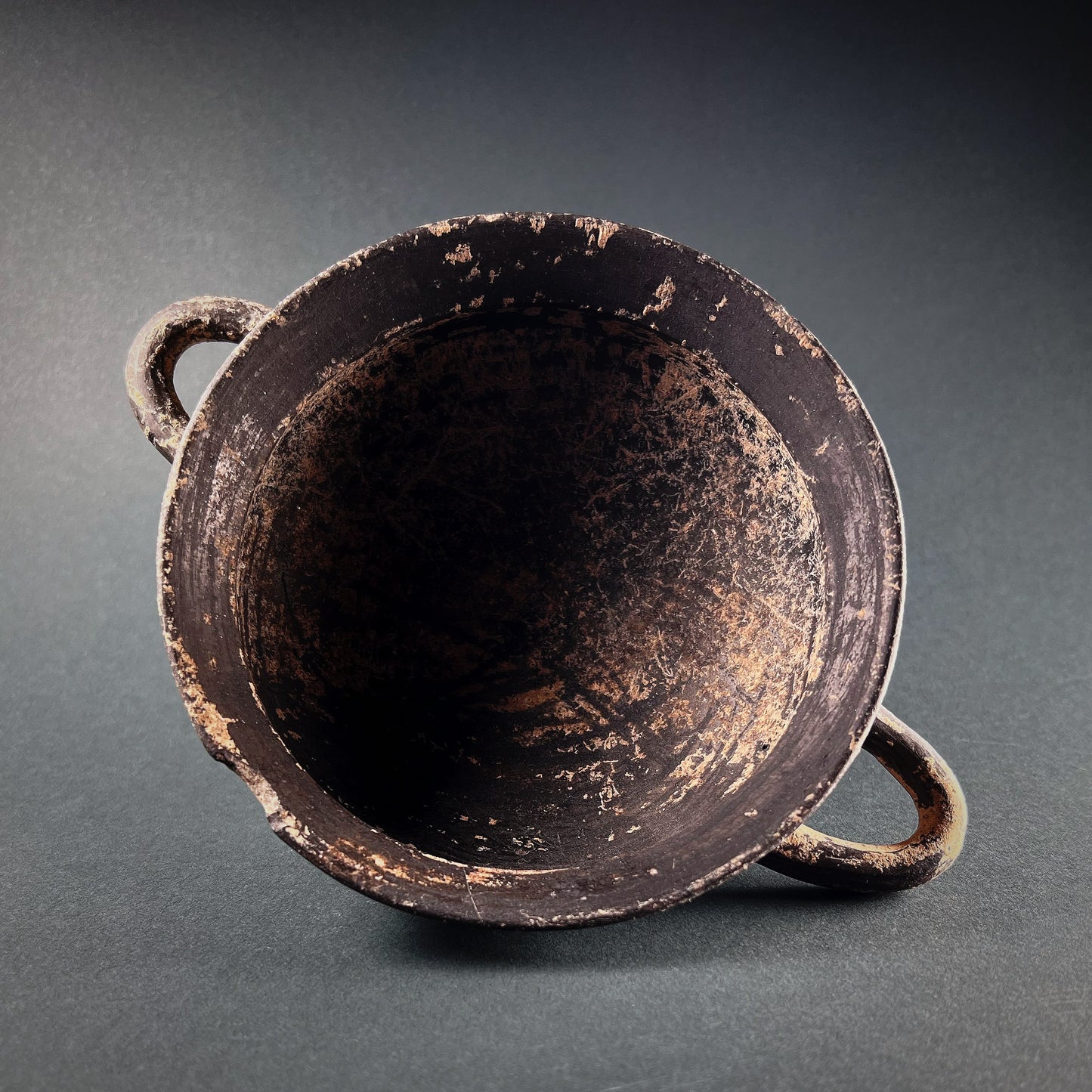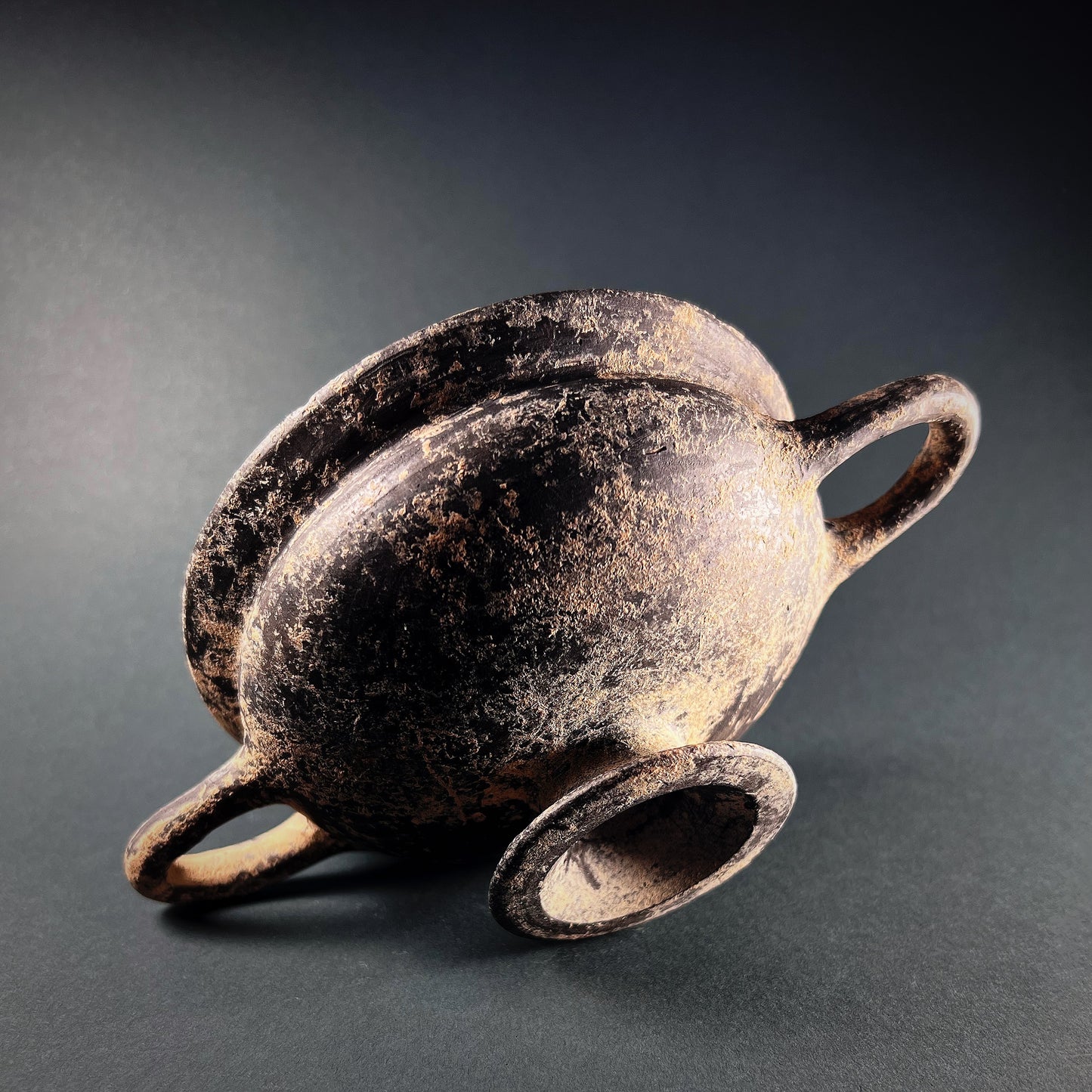Etruscan Bucchero Ware Wine Cup Kylix
Etruscan Bucchero Ware Wine Cup Kylix
Couldn't load pickup availability
Etruscan culture, Archaic period c. 600-575 BC, Etruria, Italy
Magnificent small-sized wheel-thrown bucchero nero chalice featuring rounded bowl and horizontal handles attached on the shoulder. Topped with a flared rim, this delicate chalice sits upon a stemmed, short trumpet-shaped foot. Decorated throughout with a magnificent smokey black glaze and incised bands around the body.
Bucchero, a distinctly deeply black, burnished ceramic ware, is often considered the signature ceramic fabric of the Etruscans, an indigenous, pre-Roman people of the Italian peninsula. The term bucchero derives from the Spanish term "búcaro" meaning either a ceramic jar or a type of aromatic clay. The manufacture of the bucchero ceramics was first centred in the southern part of Etruria and would later spread outside the centres of southern Etruria all the way to northern Etruria and especially the Etruscan centres of Chiusi and Vulci around 600 BC. The production of bucchero is typically divided into three artistic phases. The phases are “thin-walled or delicate bucchero” (bucchero sottile), produced c. 675-626 BC, “transitional,” produced c. 625-575 BC, and “heavy bucchero” (bucchero pesante), produced from c. 575-400BC. The most common forms found among bucchero, beginning with the sottile type, are the oinochoai, bowls, kylikes and amphoras which also come in a great variation of shapes. During the Archaic period, the ever-increasing impact of the Greek aesthetic on Etruscan culture can be noted in the influence of Greek vase shapes on the design choices of the bucchero potters. In ancient Greece the stemmed wine-drinking vessel was known as a kylix (pl. kylikes), characterised by a relatively shallow and wide body standing on a foot, with two symmetrically arranged handles. It was mainly used at symposia, as its shape allowed for drinking while reclining, as was done at banquets. The fashion for such vessels dropped off quickly from around 480 BC onwards, being replaced by stemless equivalents. Kylixes were often produced in sets to accompany a wine serving vessel, or krater.
Perfect condition. Intact piece, no restoration. Few small chips on the lip. Mineral encrustation and earthen deposits. Size approx. 6,7cm x 18,0cm x 12,6cm.
Provenance: Finnish private collection.
For a similar examples see:
Bucchero ware: Skyphos, 6th century B.C.,Princeton University Art Museum, Accession Number: y1950-34 (https://artmuseum.princeton.edu/collections/objects/23852)
Etruscan bucchero kylix (drinking cup), Museum of Fine Arts, Budapest, Accession Number: 52.822 (https://www.mfab.hu/artworks/8523/)
Cup, The British Museum, Accession Number: 1839,0214.82 (https://www.britishmuseum.org/collection/object/G_1839-0214-82)
Etruscan civilization: kylix de bucchero from Orvieto, Italy, Museo Archeologico Nazionale, Florence, Italy, Accession Number: 77509.
References and further reading:
Bucchero, Dr. Jeffrey A. Becker, Smarthistory, August 8, 2015. (https://smarthistory.org/bucchero/)
Studies in Early Etruscan Bucchero, Nancy Hirschland-Ramage, Papers of the British School at Rome, 1970, 38: 1–61. (https://doi.org/10.1017/S006824620001120X)
Bucchero Pottery From Southern Etruria, Cambridge Classical Studies, Tom B. Rasmussen, Cambridge University Press, 1979.
The Collection of Bucchero in the British Museum, Phil Perkins, Etruscan Studies: Vol. 10 , Article 3, 2007. (https://scholarworks.umass.edu/etruscan_studies/vol10/iss1/3)
Bucchero: Forms and consumption patterns in San Giovenale, Joacim Seger, Master thesis 45 hp in Classical Archaeology and Ancient History VT 2020, Department of Archaeology and Ancient History, Uppsala University (https://www.diva-portal.org/smash/get/diva2:1470174/FULLTEXT01.pdf)




-
Shipping
The shipment will be prepared in the course of 3-5 days and dispatched via Posti Group Oyj or purchased item(s) can be picked up from our shop during the store's opening hours (Tarkk’ampujankatu 4, 00140, Helsinki, Finland). Within the Finland, all items are shipped via Posti Group Oyj unless otherwise requested. We pack the items carefully and mainly in recycled materials because we want to save nature. You will receive the tracking number for your items by e-mail.
-
Returns
Returns and exchange will be accepted within fourteen days (14) of receipt at the purchaser’s cost to include freight and packaging. Items must be returned in the same condition as when they were shipped, and will not be accepted if damaged or altered in any way. Please inform us via email (info@gotanmaailma.fi) or by calling +358408408352 before sending. We do not accept returns more than 14 days after delivery.




